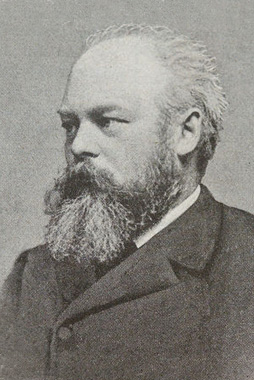Camillo Sitte facts for kids
Camillo Sitte (born April 17, 1843 – died November 16, 1903) was an Austrian architect and thinker about cities. He helped shape how we think about urban planning and how land is used in cities. Sitte is best known for his book from 1889, City Planning According to Artistic Principles. In this book, he looked at how European towns traditionally grew over time. He paid special attention to public spaces in places like Italy and Germany.
Contents
Life of Camillo Sitte
Camillo Sitte was born in Vienna in 1843. His father, Franz Sitte, was also an architect, so Camillo grew up working on building sites. He became an architect and a cultural thinker. Many German-speaking architects in the late 1800s knew about his ideas.
Sitte traveled a lot around Western Europe. He wanted to find out what made some towns feel warm and welcoming. He believed that architecture was a big part of a culture. In 1875, he became the head of a new trade school in Salzburg. Later, in 1883, he returned to Vienna to start a similar school there. His book, Der Städtebau nach seinen künstlerischen Grundsätzen (which means "City Planning According to Artistic Principles"), was highly praised when it came out in 1889.
Sitte also started the Camillo Sitte Lehranstalt (a school) and the Camillo Sitte Gasse (a street) in Vienna. He also helped create a magazine called Städtebau in 1904.
His Famous Book: City Planning According to Artistic Principles

In 1889, Camillo Sitte published his most famous book, City Planning According to Artistic Principles. The book had many drawings and maps of neighborhoods. Sitte compared parts of public spaces to how furniture is arranged in a room. He strongly argued that how a city space looks and feels should be the most important thing when planning cities. He also criticized the way industrial cities were being built in Europe at that time. This included many parts of the Ringstraße in his home city of Vienna.
Sitte was one of the first writers about cities to say that having some "irregularity" (not everything perfectly straight or symmetrical) in a city's design was a good thing. He didn't like how churches and monuments were often placed alone in big, empty spaces. Instead, he suggested using older, traditional ways of creating public spaces that had developed in Europe over many years. He showed examples of these ideas with drawings and diagrams of different neighborhoods, mostly from Italy and Germany.
Sitte believed that cities should grow step-by-step, with many well-designed smaller areas fitting into a larger plan of streets and public areas. He used his ideas to suggest improvements for Vienna's Ringstraße, showing how to make its main sites look and feel better.
Sitte's book had a big impact on how people in Europe talked about city planning and architecture. Many architects in German-speaking countries knew about The Art of Building Cities. It was published at least five times between 1889 and 1922. However, it wasn't translated into English until 1945. This might be why his ideas were not as well known in English-speaking countries before World War II. Still, his ideas reached the English-speaking world through the writings of Raymond Unwin, a British city planner who was greatly influenced by Sitte's book. Sitte's ideas also influenced other city planners like Karl Henrici and Theodor Fischer. However, some modern architects, like Le Corbusier, did not agree with Sitte's work.
For Sitte, the most important thing about a city space was its natural, creative quality. He felt that the whole feeling of a space was more than just the sum of its parts. Sitte argued that many city planners focused too much on plans drawn on paper. He believed they didn't think enough about how the spaces would actually feel. He said this made planning less effective in creating beautiful cities. Even though most of his examples came from cities in Medieval and Renaissance Europe, he also pointed to ancient Greek and Roman places like the agora in Athens and the Roman forum as examples of well-designed public spaces.
Images for kids
See also
 In Spanish: Camillo Sitte para niños
In Spanish: Camillo Sitte para niños




